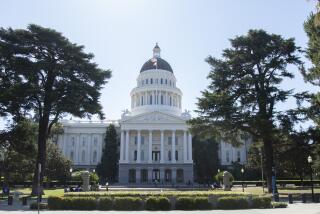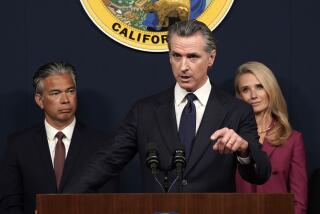Circle Some Wagons at Least
- Share via
California officials justifiably have been proud that their state Capitol was open to all, a real symbol of the democratic process. There were no checkpoints, barricades or other restraints to keep anyone from walking in off the street, strolling the marbled corridors or sitting in on a Senate or Assembly session.
In other words, the Capitol was extremely vulnerable. And times have changed. When the Joint Legislative Rules Committee meets later this month, it must be prepared to take strong and effective measures to protect the Capitol from attack.
Permanent metal detectors should be installed at all entryways, replacing the temporary ones established after Sept. 11. The U.S. Capitol has had detectors for years, as have state courtrooms, without major inconvenience. The state Capitol should too, as much as we may regret the necessity of it.
Also needed is an effective system of barriers to deter or prevent an Oklahoma City-style bomb attack. State officials have experimented in recent days with rows of round concrete planters positioned across the broad walkways, which are wide enough to accommodate a vehicle. We learned about the Capitol’s vulnerability to this sort of attack Jan. 16, when a speeding tractor-trailer rammed the south portico and doorway and burst into flames, causing $16million damage to the Capitol. The driver was killed, but no one inside the building was injured.
Some experts doubt the planters would stop a big truck traveling 70 mph. Solid concrete barriers might do the job but would be ugly. Perhaps strong metal posts would suffice and be more aesthetically acceptable.
Capitol security is not just a recent concern. On May 2, 1967, when Ronald Reagan was governor, a cadre of 30 Black Panthers, carrying rifles and other firearms, invaded the Capitol and briefly occupied the Assembly chamber before their leaders surrendered without further incident to state Capitol police. They were protesting a bill to prohibit the carrying of loaded firearms in public. The measure quickly was passed after the Panther visit.
Later, bulletproof glass was installed in the windows of the governor’s office that look out over the Capitol’s east lawn. Television cameras have been installed, and the protection of the Capitol and all state buildings now is the responsibility of the California Highway Patrol.
The state should further secure the Capitol, not out of fear but in recognition of reality. These measures may detract some from the grandeur of the building and its spirit of openness, but in no way will they curb the process of democracy.
More to Read
Get the L.A. Times Politics newsletter
Deeply reported insights into legislation, politics and policy from Sacramento, Washington and beyond. In your inbox twice per week.
You may occasionally receive promotional content from the Los Angeles Times.








